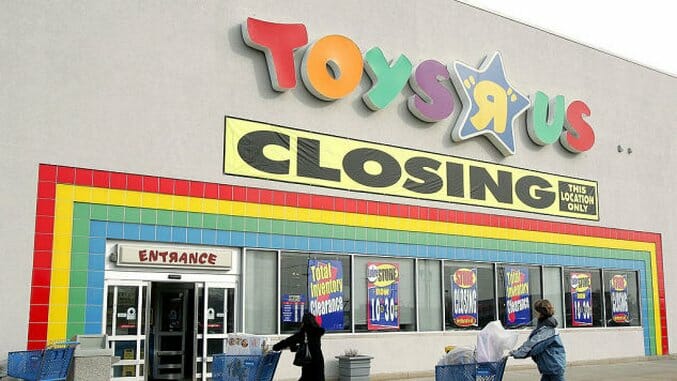Toys ‘R’ Us Files For Bankruptcy
Toy giant officially headed for the attic
Tim Boyle / Getty
Toys ‘R’ Us filed for bankruptcy Monday. The one-time toy giant is going down in the darkness, like a Playskool car willfully diving into a school furnace. According to Bloomberg the head guy, Dave Brandon, decided financial doomsday was the best moment to break into song:
At the start of his remarks in the filing, Chief Executive Officer Dave Brandon kicked things off with the company’s iconic jingle — an attempt to plumb nostalgia strings during an especially dark time for the retail chain.
“I don’t want to grow up, I’m a Toys ‘R’ Us kid.
There’s a million toys at Toys ‘R’ Us that I can play with.
From bikes to trains to video games, it’s the biggest toy store there is.
I don’t wanna grow up, ’cause if I did,
I couldn’t be a Toys ‘R’ Us kid.”
Brandon was trying to make the case that the store was going to stick around, much as Sears hangs around, as a half-visible grey shade haunting around the graveyards of American buydom. Perhaps Chapter 11 makes allowance for such wonders.
It seems doubtful, however. The Internet, among other factors, has numbered their days. Who among us wants to be one of their Toys ‘R’ Us kids now? Especially since there are no longer a million toys, or even a million dollars, in their coffers. Brandon’s speech was full of the usual “dawn of a new era” stuff they teach execs to say at business school. but this dawn seems eerily similar to the Night of Living Dead.
The downfall of Geoffrey, America’s favorite legal giraffe, is the end of something beautiful and by beautiful, I mean a publicly-traded store that used a backwards “R.” This kind of font-based frivolity was pushed out of the door back in the Nineties, like so much high-grade Depression hooch. Now backwards letters are only glimpsed here and there in America, in the letters of children and the handwritten memos of the President of the United States.
If Toys ‘R’ Us really goes, then the backwards R will more or less vanish from the mini-malls that cover so much of this continent. The fun-time retailer was its last reliable haunt in public view, and now that it has vanished, who will teach the children to plaintively decorate their letters with kid-whimsy?
According to public records, unlike the late Rodney Dangerfield, Toys ‘R Us refused to pray for death, and kept on trucking, as much trucking as was possible. It was debt that shut them down, that shuttered them: five billion dollars of it. Per the Post:
Toys R Us has been spiraling toward bankruptcy for years as it failed to keep up with competitors. Analysts cited many reasons for the company’s demise: Lousy in-store customer service, a second-rate website and prices that are often higher than at many of its big-box competitors. Add to that piles of mounting debt — much of it dating to a 2005 leveraged buyout — and it was clear, many said, that the 60-year-old brand was in trouble. “When you’re cursed with all this debt, there’s no way you can compete anymore,” said Howard Davidowitz, a retail consultant who worked with Toys R Us in the 1980s and 1990s. “Now they’re running up and down the halls trying to pick up the pieces, but there’s no way around it: This is a very bad situation, and it will weaken the company forever.”
The chain said they’d keep stores open; who can say how long that will last? Time was, the New Jersey company was the nation’s biggest wheel on the toy circuit. Even today, they own 1600 stores worldwide, employing roughly 65,000 people. Strange, that toy magnates were once a thing—it seems otherworldly, when we consider it in the bleak retail hangover that is the New Economy.
Amazon reaps everything, in the end. As one Internet commenter pointed out, under communism, the citizens got all their goods from a single, state-owned retailer. In late-stage capitalism, we all buy our material from Amazon. What a vast distinction between the two systems. “Poetic” isn’t exactly the right word for what has happened to Toys ‘R’ Us—but “preordained” might be. As the other toy stores began to fall, Toys ‘R’ Us snapped them up. Geoffrey was a consumer of the first order. Consider FAO Schwartz, another vanished relic of the toy-store age, was bought by Toys ‘R’ Us—it suffered a downturn and then a buy-out, just like KB Toys and all of the other one-time toy magnates that used to sprawl across North America. Toys ‘R’ Us was a Wal-Mart for toys, and that’s not a good thing.
The Wall Street Journal argued that Toys ‘R’ Us was a typical example of a “category killer”—a retailer who hunted hundreds of independent and self-sustaining toy stores to extinction:
“They are the last major free-standing toy retailer in the U.S.,” said Jim Silver, the chief executive of TTPM, a website that reviews thousands of toys each year for consumers. As the testing ground for new products, Toys ‘R’ Us often identifies hits before rivals, as it did with ZhuZhu pets in 2009, Mr. Silver said. “But like many other big-box chains, including Borders, Circuit City and Sports Authority, Toys ‘R’ Us struggled with the rise of discounters like Wal-Mart Stores Inc. and Target Corp. , and more recently, Amazon.com Inc. It was late to develop and expand its e-commerce business and placed big bets on licensed toys for ‘Star Wars’ and Lego movies that missed expectations.”
Toys ‘R’ Us is the archetypal example of the carnivore who is consumed in turn. Toys are one of the first purchases Americans make with their own money, and there’s an odd poetry that the last graduate of the toy wars should be the first whale of retail to be harpooned this fall. As the latter days of the Internet have shown us, like everything else in America these days, selling toys is hardly recess. Toys ‘R’ Us made sport of their competitors and creditors, and now their competitors make sport of them. As in most games, fair play holds.







































